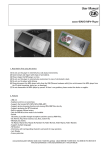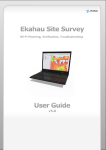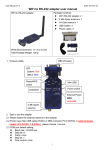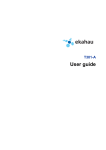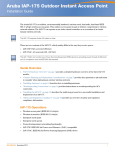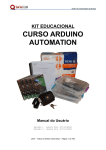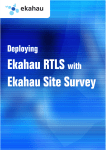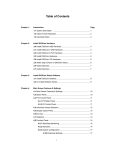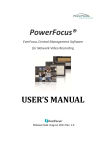Download EPE_User Guide
Transcript
Ekahau Positioning Engine 4.4 User Guide Ekahau, the Ekahau logo, Ekahau Site Survey, Ekahau Location Survey, Ekahau Engine, Ekahau Positioning Engine, Ekahau Manager, Ekahau Activator, Ekahau Finder, Ekahau Tracker, Ekahau Logger, Ekahau T201, Ekahau T301, Ekahau NIC-54 and Ekahau Client are trademarks or registered trademarks of Ekahau. Other product and company names may be trademarks or trade names of their respective owners. The enclosed software contains implementations of Ekahau’s patent pending inventions. This manual and the Ekahau software described in it are copyrighted, with all rights reserved. This manual and the Ekahau software described in it may not be copied, except as otherwise provided in your software license. The contents of this document are provided “as is.” Except as may be required by applicable law, no warranties of any kind, either express or implied, including, but not limited to, the implied warranties of merchantability and fitness for a particular purpose, are made in relation to the accuracy, reliability or contents of this document. Ekahau reserves the right to revise this document or withdraw it at any time without prior notice. Export of this technology may be controlled by the United States Government. Diversion contrary to U.S. law prohibited. Your use of the Ekahau software described in this user manual and its documentation are governed by the terms set forth in your license agreement. Your use of this Ekahau software contrary to the terms of this User Manual may void the warranty, if any, described in your license agreement. Under no circumstances shall Ekahau be responsible for any loss of data or income, or any special, incidental, punitive, consequential or indirect damages howsoever caused. You may not use any Ekahau software or hardware products in hazardous environments (such as operation of nuclear facilities, aircraft navigation or control, environments containing high levels of dust, or mines) or in Life-Critical Solutions, unless you have advised Ekahau that they will be used in a hazardous environment or in a Life-Critical Solution and Ekahau has had an opportunity to evaluate further whether, and on what terms and conditions, the software or hardware products may be licensed for your intended use. The term “Life-Critical Solution” means an application software package or hardware device whose functioning or malfunctioning may result directly or indirectly in physical injury or loss of human life. Ekahau tags must always be used in compliance with the user environment and instructions contained in the User Manual for the tags. Copyright © Ekahau, Inc. 2000-2008. All rights reserved. Ekahau Positioning Engine 4.4 iii Table of Contents 1 Introduction ....................................................................................................................... 1 1.1 Ekahau Real-Time Location System ........................................................................ 1 1.2 This Product ............................................................................................................. 3 1.2.1 Overview ...................................................................................................... 3 1.2.2 Ekahau Positioning Engine Features ........................................................... 3 1.3 System Requirements .............................................................................................. 3 1.4 Technical Support .................................................................................................... 4 2 Getting Started ................................................................................................................. 5 2.1 What's New .............................................................................................................. 5 2.1.1 Features ....................................................................................................... 5 2.2 Installation ................................................................................................................ 5 2.2.1 Installer ........................................................................................................ 5 2.2.2 After Installation ........................................................................................... 6 3 Ekahau Positioning Engine ............................................................................................. 9 3.1 System ................................................................................................................... 10 3.1.1 System Status ............................................................................................ 11 3.1.2 Activity ........................................................................................................ 11 3.1.3 Log File ...................................................................................................... 12 3.1.3.1 Log Levels .................................................................................. 12 3.1.4 Licenses ..................................................................................................... 12 3.1.4.1 Upload New License ................................................................... 13 3.2 Tags ........................................................................................................................ 13 3.2.1 Tag List ....................................................................................................... 13 3.2.2 Search Options .......................................................................................... 14 3.2.2.1 Tags ............................................................................................ 14 3.2.2.2 Group ......................................................................................... 15 3.2.2.3 Config .......................................................................................... 15 3.2.2.4 Find ............................................................................................. 16 3.2.2.5 Find Keywords ............................................................................ 16 3.2.3 Tag Properties ............................................................................................ 18 3.2.3.1 Actions ........................................................................................ 19 3.2.3.2 Commands Pending ................................................................... 20 3.2.3.3 Configuration Dump from Tag (T201 only) .................................. 20 3.2.3.4 Latest Delivered Commands (T301 only) ................................... 20 3.2.4 Actions ....................................................................................................... 20 3.2.4.1 Add To Group .............................................................................. 21 3.2.4.2 Create New Group ...................................................................... 21 3.2.4.3 Set Configuration ........................................................................ 21 3.2.4.4 Remove from Group ................................................................... 21 3.2.4.5 Advanced... ................................................................................. 21 3.3 Groups ................................................................................................................... 21 3.4 Configs ................................................................................................................... 22 3.4.1 Create a New T201 Configuration ............................................................. 22 3.4.1.1 General ....................................................................................... 22 3.4.1.2 Network ....................................................................................... 22 3.4.1.3 Ekahau Positioning Engine ......................................................... 23 3.4.1.4 Periodic Location Update ............................................................ 23 3.4.1.5 Motion Sensor ............................................................................. 23 3.4.1.6 Button ......................................................................................... 24 Ekahau Positioning Engine 4.4 iv 3.4.1.7 Advanced .................................................................................... 24 3.4.2 Create a New T301 Configuration ............................................................. 24 3.4.2.1 General ....................................................................................... 24 3.4.2.2 Advanced Network Settings ........................................................ 24 3.4.2.2.1 Network ....................................................................... 25 3.4.2.2.2 Tag IP Settings ............................................................ 25 3.4.2.2.3 Ekahau Positioning Engine ......................................... 25 3.4.2.3 Periodic Location Update and Maintenance ............................... 26 3.4.2.4 Sensors ....................................................................................... 26 3.4.2.5 Advanced Scan Settings ............................................................. 27 3.4.2.6 Battery Lifetime Estimation ......................................................... 27 3.4.3 Create a New T301-I Configuration ........................................................... 27 3.4.3.1 General ....................................................................................... 27 3.4.3.2 Network ....................................................................................... 28 3.4.3.3 Tag IP Settings ............................................................................ 28 3.4.3.4 Ekahau Positioning Engine ......................................................... 28 3.4.3.5 Periodic Location Update ............................................................ 29 3.4.3.6 Motion Sensor ............................................................................. 29 3.4.3.7 Advanced Scan Settings ............................................................. 29 3.4.4 Upload a Configuration File ....................................................................... 30 3.4.5 Set Default Configuration ........................................................................... 30 3.4.6 Duplicate .................................................................................................... 30 3.4.7 Tag Firmware ............................................................................................. 30 3.4.8 Device Support Information ....................................................................... 31 3.5 Models ................................................................................................................... 31 3.5.1 Upload New Model .................................................................................... 31 3.5.2 Updating a Model ....................................................................................... 32 3.5.3 Model Properties ........................................................................................ 32 3.6 Activating a Model .................................................................................................. 32 3.7 Users ...................................................................................................................... 32 3.7.1 Create a New User .................................................................................... 32 4 System Configuration .................................................................................................... 35 4.1 Ekahau Client Connector ....................................................................................... 35 4.2 Network Configuration ........................................................................................... 35 5 Ekahau Positioning Engine Maintenance .................................................................... 37 5.1 Backing up the Ekahau Positioning Engine ........................................................... 37 5.2 Restoring the Ekahau Positioning Engine .............................................................. 37 5.3 Downgrading to an Earlier Version ........................................................................ 37 5.4 Editing the Ekahau Positioning Engine Configuration Parameters ........................ 38 5.5 Changing Allocated Memory Size .......................................................................... 38 5.6 SNMP Monitoring ................................................................................................... 39 Index ..................................................................................................................................... 41 Chapter 1. Introduction 1 1 Introduction Welcome to Ekahau Positioning Engine (EPE), the core element of Ekahau Real-Time Location System. It leverages standard 802.11 wireless networks and state of the art location tracking algorithms to locate people or assets using Ekahau’s Wi-Fi Location tags or any supported Wi-Fi enabled laptop or PDA. This user guide helps you in understanding how to install and use the EPE. 1.1 Ekahau Real-Time Location System Ekahau RTLS (Real-Time Location System) is a quick and easy way to locate people and assets. With Ekahau RTLS, you can improve your business operations, save money and become more efficient. Once in use, Ekahau RTLS keeps key employees within easy reach and decreases the time it takes to find vital pieces of equipment or inventory. By streamlining operations, Ekahau RTLS allows you to focus your time and resources to more important details. Ekahau RTLS makes sure that people and things can be found - in the right place, at the right time. Award Winning Concept The wireless networks that are used for data and voice today provide an excellent platform for building accurate location-tracking systems. Unlike other proprietary systems, Ekahau’s system relies on standard 802.11 wireless networks to deliver a comprehensive real-time location system (RTLS) for locating your valuable equipment and people in real time. Because the existing wireless network infrastructure is used, deployment is more cost effective where a wireless network is already in use. This provides additional justification for installing new networks. Deployment of Ekahau RTLS does not interrupt network activities or affect other network communications. With Ekahau RTLS, the positions of equipment and people are automatically updated and can be delivered to other systems and personnel that call for this information. The fact that information about the needed equipment or persons is readily available leads to cost savings, because the assets are utilized more efficiently and the workflow is optimized. Moreover, the system enables new processes, such as the automatic routing of security personnel to the location where a tag alarm button was pressed or a tamper switch was activated. Chapter 1. Introduction 2 Product Components Ekahau RTLS is a whole tracking solution for asset and people tracking. It consists of the following integrated components Component Description Supported Platforms Ekahau Position- Server software for location tracking, Wi-Fi tag config- Windows® XP, Windows® 2003 ing Engine™ uration and management. HTTP / XML API for Server applications. Ekahau Site Sur- Application for creating and editing positioning mod- Windows® XP, Windows® 2000, vey™ els. Windows® Vista Ekahau Vision™ End-user application for grouping, locating and view- Windows® XP, Windows® 2003 ing the location of people and assets in real time, Server monitor events, and invoke notifications or alarms. Ekahau Tracker™ End-user application for real-time tracking, event monitoring, dispatching alarms and analyzing the locations of assets and people. Windows® XP Ekahau Wi-Fi Tags - Wi-Fi location tag Chapter 1. Introduction 3 Component Description Supported Platforms Ekahau Client Software based solution to provide location tracking, capabilities for Wi-Fi enabled devices. Reference implementation and Ekahau Tag Protocol documents available to Located by Ekahau™ partners. Windows® Vista, Windows® XP, Windows® 2000, Windows® Mobile 6, Windows® Mobile 2005, Windows® Pocket PC 2003, Windows® CE 4.2, Windows® CE 5.0 1.2 This Product This chapter provides an overview of product capabilities and features, highlighting the new features in this release. 1.2.1 Overview Ekahau Positioning Engine is the brain of the Ekahau RTLS. It is a web service that runs on a dedicated Windows® server. The features have been designed to make system deployment, tag management and system administration easy and efficient. The web service architecture makes integration to other systems simple, HTTP based API can be accessed from virtually any platform and programming language. 1.2.2 Ekahau Positioning Engine Features Ekahau Positioning Engine has a easy-to-use web browser user interface and it provides the following functionality: ● ● ● ● ● Ekahau Positioning Engine allows wireless configuration of Ekahau Wi-Fi Tags. The tags can be assigned into groups to support various tag management and deployment activities. The patented location tracking algorithm receives signal strength measurements from Ekahau Wi-Fi tags, compares the received measurements to an existing reference data and a positioning model, and calculates accurate location estimates. Event Handler receives events such as call button presses or tamper switch alerts from tags, routing them to applications and including the location of the tag that initiated the event. Systems and devices management that automates management tasks and monitors the system. Open application APIs for integrating 3rd party applications to the system. The APIs provide location feeds, location queries and events to the application, using APIs that comply with web standards. 1.3 System Requirements Ekahau recommends installing Ekahau Positioning Engine on a dedicated server running Windows® 2000, Windows® XP Professional, or Windows® 2003 Server. The server must have at least Intel® Pentium® 4, 1 GB RAM, and 500 MB available HD space. Chapter 1. Introduction 4 Recommended Hardware Setups Use Case Recommended Hardware Tracking area below 50.000 ft² (5.000 m²), less than 100 tags Windows® XP Professional Intel® Pentium® 4 1 GB RAM Tracking area below 500.000 ft² Windows® XP Professional or Windows® 2003 Server (50000 m²) and less than 500 Intel® Pentium® 4 or Intel® Xeon® Tags 1 GB RAM Tracking area more than Windows® 2003 Server 500.000 ft² (50000 m²) or more Intel® Xeon® than 500 tags 2 GB RAM Supported Web Browsers Ekahau Positioning Engine administration user interface is accessible with a web browser. Supported web browsers are Microsoft Internet Explorer 6 or newer and Mozilla Firefox 1.0 or newer. JavaScript must be enabled in the web browser option to make some of the actions work. 1.4 Technical Support Ekahau provides technical support free of charge for all customers for 30 days. Customers who have purchased Ekahau Support will receive Ekahau Support services for 12 months from the date of purchase. Ekahau Support includes: ● ● All upgrades and patches for the product(s) and documentation purchased Free-of-charge support via e-mail (preferred) and telephone during regular business hours (PST, EST, GMT+2) Bug fix patches are free of charge for all customers. To renew your Ekahau Support, please contact your Ekahau representative or [email protected]. Chapter 2. Getting Started 5 2 Getting Started This chapter describes how to install and start using the Ekahau Positioning Engine product. 2.1 What's New This section provides an overview of the new product features and the changes that have been made to previous versions. If you are new to the Ekahau Positioning Engine product, you may decide to skip this section and proceed to subsection Installer on page 5. 2.1.1 Features New Ekahau Positioning Engine Features in version 4.4 ● ● ● New supported devices ○ Ekahau T301-BD tag ○ Ekahau Client 4.0 ○ Text messages can be sent to tags from the Ekahau Positioning Engine user interface and Messaging API ○ Menu API can be used, for example, to implement application specific pre-defined responses to messages Aruba Networks Integration ○ Minimal bandwidth consumption and increased tag battery life with supported ArubaOS version Tag configuration form requires less input from the user, by default the tags preserve the wireless network, IP address and port settings set using Ekahau Activator. New Ekahau Positioning Engine Features in previous version 4.3 ● ● ● ● Presence detection based on tag IP address or associated access point MAC address Zone Enter and Zone Exit events have intelligent smoothing when a tracked device is close to the edge of the zone. False enter/exit events are automatically filtered by EPE Battery lifetime estimates for tag configurations Positioning Model can be Updated without changing model ID number 2.2 Installation This chapter describes how to install Ekahau Positioning Engine. 2.2.1 Installer Launch the Installer and follow the on-screen instructions to finish the installation. An existing installation will be automatically upgraded just by running the installer. Chapter 2. Getting Started 6 Configuration Parameters The following parameters can be set to customize TCP / UDP ports and to optimize Ekahau Positioning Engine performance by allocating system resources. Installation Parameter Description Dedicated Server Mode Select the Dedicated Server Mode if the Ekahau Positioning Engine is running on a dedicated server. This option is recommended for production use. Multi-Purpose PC Mode If Ekahau Positioning Engine is installed on a PC that is running other applications (for example Ekahau Location Survey or development tools), select this option. Migration If the installation folder contains a backup copy of a Ekahau Positioning Engine database, the installer asks if you want to restore database contents from the backup file. Main Server Port This is the TCP port number for Ekahau Positioning Engine Administrator user interface, Application Programming Interface (API) and Ekahau T201 Wi-Fi Tag maintenance calls. Location Protocol (UDP) UDP port on which Ekahau Positioning Engine is listening to Ekahau Location Protocol (ELP) events Maintenance Protocol(UDP) UDP port on which Ekahau Positioning Engine is listening to Ekahau Maintenance Protocol (EMP) calls T301 Firmware Update (UDP) UDP port through which Ekahau Positioning Engine updates T301 tag firmware T201 Location Update (TCP) TCP port on which Ekahau Positioning Engine is listening to location updates from T201 tags T201 Location Update (UDP) UDP port on which Ekahau Positioning Engine is listening to location updates from T201 tags Database Server (TCP) TCP Port on which the Ekahau Positioning Engine database is running Server Shutdown (TCP) Ekahau Positioning Engine shutdown script sends the shutdown command to this TCP port. Change the port number if it is already in use. A license file is not needed during the installation process. The license file(s) is/are uploaded after installation via the administrator user interface. For instructions, see subsection Licenses on page 12 2.2.2 After Installation The Ekahau Positioning Engine administrator user interface can be accessed with a web browser. The service address is http://<Engine host IP address>:8550. The default user name / password is admin/admin Note 7 Chapter 2. Getting Started The default password for the admin user should be changed immediately after the first login. The password can be changed from Users page by clicking on the admin user in the user list. Chapter 2. Getting Started 8 9 Chapter 3. Ekahau Positioning Engine 3 Ekahau Positioning Engine This chapter describes the Ekahau Positioning Engine product features and functions, and the user interface. Ekahau Positioning Engine enables over-the-air configuration and management of Ekahau Wi-Fi tags. It provides an easy-to-use web browser user interface for defining and editing tag configuration parameters in order to support various application requirements. For example, tags can be configured to update the location in real time, during and/or after a detected motion, or when the tag’s alarm/acknowledgment button has been activated. The active configuration of one or more tags can be changed with a single click. Ekahau Wi-Fi tags connect to Ekahau Positioning Engine automatically upon configurable intervals ("maintenance call") to synchronize the configuration information, thus allowing the user or an application to edit the tag’s configuration also after it has been deployed. The user may also request one or more tags to blink LEDs or play the tag’s buzzer. When connected to Ekahau Positioning Engine, the tags will report certain parameters (serial number, battery level, firmware version) that can later be used to find them. The user may also define tag property values and categorize tags into groups that can also be used as search options while managing or deploying the tags. The user may also set a default configuration that is automatically associated with all new tags connecting with the Ekahau Positioning Engine service for the first time. When the tags are taken into use, they are configured to contact the Ekahau Positioning Engine service to update the location information whenever enabled location update events take place. There are four different event types: periodic (for example, once every 10 minutes), during detected motion, after detected motion, and when the tag's button has been pressed. Chapter 3. Ekahau Positioning Engine 10 For the application developers,Ekahau Positioning Engine is a web service. The location information is available for applications through an open HTTP request / XML response based Application Programming Interface. The location algorithm applies user defined pass / fail criteria to filter out location estimates that do not meet the application specific accuracy requirements. The developers do not have to understand how the Wi-Fi tags are configured and how the location algorithm works. They can concentrate their application design and development efforts on translating the location update events into valuable information. 3.1 System The system page provides an overview of the system status. Chapter 3. Ekahau Positioning Engine 11 3.1.1 System Status Parameter Description Version Version number Build number Product build number Started Date and time when the Ekahau Positioning Engine service was started Uptime How long the Ekahau Positioning Engineservice has been running (Current time Start time) Number of Tags Current number of tags in the system, and the maximum number of software license permits. If the license limit is exceeded, the system page displays a notification. 3.1.2 Activity Parameter Description Location Update Events Number of received location update events from tags (periodic, motion, after motion, button) Locations Number of location estimates that passed the set location quality filter Filtered Locations Number of location estimates that did not pass the set location quality filter Maintenance Calls Number of maintenance calls from the tags Counters Started Time when the counters were reset Activity counter values can be used to verify that the system is working as expected. To reset the counter values, click the Reset Activity Counters link. Chapter 3. Ekahau Positioning Engine 12 3.1.3 Log File Ekahau Positioning Engine log file contains information about system activity, including errors and warnings. 3.1.3.1 Log Levels Log level configuration allows the user to edit the number and type of logged system events or errors. No changes are needed to log levels, changes are only needed for troubleshooting purposes. By default, the Engine logs all system warnings and errors. Restarting the Engine will set the log levels back to the default value. Engine API Calls Log Application-initiated HTTP requests and received parameters. Maintenance Calls (T201) Log maintenance calls from T201 tags. Location Update Events (T201) Log tag-initiated location update events. Maintenance Protocol Calls Log maintenance calls from tags, or Wi-Fi devices using Ekahau Maintenance Protocol. Location Protocol Events Log location update events from tags, or Wi-Fi devices using Ekahau Location Protocol. SQL Statements Log performed SQL statements for all database queries. Other Engine Categories Log other Ekahau Positioning Engine events, default level INFO. All Other Categories Logging for all other categories. 3.1.4 Licenses License details are listed here. An Ekahau Positioning Engine software license limits the number of tags in the system. Each tag in the tag list requires a license, and only the listed tags are located. To free a license, tags which have been removed from use can be deleted from the tag list. Tags are deleted through the tag property page. For instructions, see subsection Tag Properties on page 18 Chapter 3. Ekahau Positioning Engine 13 Each new uploaded license file increments the tag limit. Uploading two separate 100-tag license files equals uploading one 200-tag license file. 3.1.4.1 Upload New License To upload a new license file, click the Browse... button first to locate the license file in the file system. Then click the Upload button. After a successful upload the number of license files and the tag limit will be incremented in the license summary section. 3.2 Tags This page lists the tags that have completed a maintenance call or sent a location update event to Ekahau Positioning Engine. The search options above the list allow you to filter the listed tags in many ways. The list can be sorted by clicking the column headers. The check box on the left side of each row can be used to select one or many tags for further actions (see subsection Actions on page 20). All and None buttons below the check box column allows the user to select or deselect all tags with a single click. Tags are configured and assigned into groups via the Actions option below the list. Once a tag has been associated with a configuration, the tag will automatically receive all changes made to the configuration. Tags that have pending configuration changes or commands are listed with bold font. The Maint column will be highlighted in red color if the tag has not completed a maintenance call according to the configuration parameters. Tag properties (name, custom text, movement profile) can be viewed and edited by clicking the tag serial number link. Configuration changes and commands (LED, Buzzer, Firmware upgrade) may be applied to the tag through the tag properties page as well. To modify the properties of many tags at the same time, first select the tags from the list and then click the Advanced... button below the list. If a tag for any reason fails to apply the configuration parameters or commands, the tag will be highlighted in red color in the list. The tag properties page will display information pertaining to why the configuration could not be applied. Tag groups can help you to manage and monitor the tags before and after the tags have been deployed. Tip New tags that have not yet been assigned a configuration can be listed by selecting the <none> option from the Config search option list. 3.2.1 Tag List By default, the tag list is ordered by last location update time, and only the 100 most recent updates are listed ("Most Recent" view in Tags view list). Chapter 3. Ekahau Positioning Engine 14 Tag List Columns Column Description Tag Serial number of an Ekahau Wi-Fi tag. Placing the mouse pointer over the serial number will display further details. Clicking the link will open the tag properties page, where many operations can be performed. Name Name parameter assigned for the tag. Each tag can be named by the asset or individual associated with the tag. MAC MAC address of the tag. Config Name of configuration (set of configuration parameters) currently in use. Batt Battery level received from the tag during the latest maintenance call or location update. The battery level is highlighted in red color when the percentage is below the configured "low battery" limit. This limit can be set through the epe.properties file, by default located in C:\Program Files\Ekahau\Ekahau Positioning Engine\conf Map Map from the last location update that passed the location estimate quality requirements. The location is highlighted in orange color if the engine has received successive location update events but the location estimates have failed to meet the requirements. "Filtered" location estimates are never displayed in the tag list. They can be viewed through the tag properties page. Zone Zone from last successful (see the Map column description above) location update. Site* Site name from last successful presence update. *This column is visible only when the presence option is enabled in the EPE license. Loc Relative time when the last successful location update was received. Maint Relative time when the tag performed the last maintenance call. 3.2.2 Search Options Search options allow you to list tags based on many parameters. Next, you can use the Actions button to quickly modify the configuration of the listed devices. The following sections describe the available search options. The listed tags match all set search parameters, when more than one search parameter is applied. 3.2.2.1 Tags Most Recent By default, the tag list displays the 100 most recent location updates. The number of the most recent tags can be configured through the configuration files. No Location Lists the tags that have completed a maintenance call, but have not been located by the system so far. These tags have most likely just been added to the system and have completed one maintenance cycle. Chapter 3. Ekahau Positioning Engine 15 Low Battery Lists the tags that have reported a battery level that is below the low battery limit in the last maintenance call or location update. Pending Commands Lists the tags that have pending commands, such as configuration changes, LED / Buzzer events, a Firmware upgrade, or manual commands set through the Tag properties / Advanced commands page. Location Update Overdue Lists the tags for which the scheduled periodic location update time has expired. Last Location Update Filtered The latest location update was completed successfully, but the resulting location estimate fails to meet the location quality requirements. Maintenance Overdue Lists the tags for which the scheduled maintenance call time has expired. Command Error A tag configuration update, a LED / Buzzer event, a Firmware upgrade, or manual commands could not be applied successfully. The Tag Properties page will display an error description. T301 Lists all Ekahau T301 series tags in the system. T201 Lists all Ekahau T201 tags in the system. All Tags Lists all tags in the system. When the search options above the tag list are applied, the Tags view is automatically set to this option. 3.2.2.2 Group Lists the tags assigned to a selected group. When empty, the tags assigned to any or none of the groups are listed. 3.2.2.3 Config Lists the tags using the selected configuration. When empty, tags using any or none of the configurations are listed. The <NONE> option lists tags for which no configuration has been set Chapter 3. Ekahau Positioning Engine 16 3.2.2.4 Find Entering text into the Find field lists the tags with fully or partially matching text in the Tag (serial number), Name, MAC, Map, Zone or user-defined Custom field. 3.2.2.5 Find Keywords The advanced search options include keywords that can be used to limit the text search into one field. Usage: enter "keyword=value" into the Find field and press the Find button. SERIAL Lists the tags with matching text in the Serial number field. SERIAL=T301-0906 MAC Lists the tags with matching text in the MAC address field. MAC=00:10:C6:97:99:21 MAC=97:99 NAME Lists the tags with matching text in the user-defined Name field. NAME=Pump1203 CUSTOM Lists the tags with matching text in the user-defined Custom data field. CUSTOM=Baxter TYPE Lists the tags with matching text in the Tag type field. TYPE=T201 TYPE=T301 VERSION Lists the tags with matching text in the Firmware version or Hardware version field. VERSION=1.0.1 Chapter 3. Ekahau Positioning Engine 17 MAPNAME Lists the tags with matching text in the Last location map / Floor name field. MAPNAME=5thfloor ZONENAME Lists the tags with matching text in the Last location zone name field. ZONENAME=engineering SITENAME Lists the tags with matching text in the Last location site field. SITENAME=warehouse2 BATTERY Lists the tags with the last reported battery level between the given percentage range. BATTERY=0-50 Lists tags with battery level below 50% and above 0%. LASTLOC Lists the tags with the last successful location update within the given time. LASTLOC=20s Lists the tags updated within the last 20 seconds. LASTLOC=5m Lists the tags updated within the last 5 minutes. LASTLOC=2h Lists the tags updated within the last 2 hours. LASTLOC=6d Lists the tags updated within the last 6 days. LASTLOCNOT Lists the tags for which location has not been updated within the given time period. LASTLOCNOT=20s Chapter 3. Ekahau Positioning Engine 18 Lists the tags not updated within the last 20 seconds. LASTLOCNOT=5m Lists the tags not updated within the last 5 minutes. LASTLOCNOT=2h Lists the tags not updated within the last 2 hours. LASTLOCNOT=6d Lists the tags not updated within the last 6 days. LASTMAINT Lists the tags that have completed a maintenance call within the given time period. LASTMAINT=5m Lists the tags that have completed a maintenance call within the last five minutes. LASTBUTTON Lists the tags that have reported a button press event within the given time period. LASTBUTTON=8h Lists the tags that have reported a button event within the last eight hours. 3.2.3 Tag Properties Clicking the tag serial number will open a page listing the tag properties. Here you can change the device’s active configuration, update the firmware, or send manual commands to the tag. Having associated a tag with a configuration, the device will receive all modifications you make to the configuration upon the next scheduled maintenance connection. If the tag’s configuration has been changed but the tag has not yet received the commands, these commands are displayed under the Commands Pending heading Tag Property Description Serial Number Tag serial number MAC Tag MAC address Type Tag type information Version (firmware/hardware) Tag firmware version and hardware revision information Created On Date and time when the tag completed the first maintenance call Active Configuration Assigned tag configuration Battery Level Battery level reported during the last location update or maintenance call Signal Normalization For supported devices, name of the signal normalization function is displayed. List of supported devices can be found on the Config page Chapter 3. Ekahau Positioning Engine 19 Tag Property Description Last Location Update Last location estimate (that has passed the location quality filter). The location can be viewed on the floor plan by clicking the map link. The update type (periodic, button press, motion) link after the update date & time will open a list of access points and signal strengths that were used to estimate the latest location. Last Presence Update Last location resolved using a presence model. This property is visible only when a presence model is active in the system. Last Maintenance Call Time when the last maintenance call was completed 3.2.3.1 Actions User Data Each tag has two user defined properties: Name and Custom Name property can be used to set the name of the person or asset associated with the tag. You can search and find tags by name by using the tag list Find function. Maximum length for the name is 30 characters. Custom field can be used to store additional information about the tag or associated asset (make, model, year, month) or person. Custom field text can also be used to find the one or many tags matching with the given Find field search criteria. Member of Groups check boxes can be used to apply the group membership selection for the tag(s). After editing the user data fields or group selections, click the Save button to apply the changes. Commands Buzzer Plays the tag's buzzer after the tag has completed the next maintenance call. Buzzer duration can be selected from the drop-down menu. LED Flashes the tag's LEDs after the next scheduled maintenance call. LED flash duration can be selected from the drop-down menu. Set Config Selects a configuration for the selected tag. Request info Requests the tag to resend the properties (serial number, version information etc.) Request config dump Select this option to download tag configuration from the tag upon the next maintenance call. The downloaded configuration can be copied into a text file. The file can be uploaded to create a new configuration through the Configs page. For upload instructions, see subsection Upload a Configuration File on page 30 Manual commands commands Use this field to send manual commands to the tag. The commands must be valid tag command line interface commands. The tag will return an error message if the entered commands could not be applied. Update Firmware Update tag software version upon next maintenance call. Chapter 3. Ekahau Positioning Engine 20 Message and Message Type fields can be used to send a text message to a tag with a message display. Instant messages are only displayed immediately when they are received, standard messages are stored in the tag's memory. The Send Commands button below the command list saves the selected commands. The tag will complete the requested commands after completing the next maintenance update. The tag list will highlight the tag in red color if the tag has failed to apply and acknowledge the selected commands. Clear button will remove the commands that are currently pending. Note Clear button will not remove tag configuration change specific commands that are currently pending, only buzzer, LED, info request, configuration dump, firmware update or manual commands. Create New Group The tag(s) can be assigned to a new group by entering the group name and clicking Create New Group button. The new group is automatically created during the process. Delete Deletes tag from the tag list. The tag will re-appear in the list after completing the next location update or maintenance call. Thus tags should be deleted after they have been switched off. 3.2.3.2 Commands Pending This section lists the commands that are currently pending for the tag. 3.2.3.3 Configuration Dump from Tag (T201 only) After the tag has completed the configuration download request, the configuration parameters are listed here. By copying the downloaded configuration into a text file, you can create a new configuration by using the Upload configuration File on the Config page. For instructions, see subsection Configs on page 22 3.2.3.4 Latest Delivered Commands (T301 only) This section lists the latest commands and command parameters the tag has received. This is useful information if tag's configuration has been changed with manual commands. 3.2.4 Actions To change the configuration of multiple devices, first apply search criteria to list the devices you wish to configure. Next, select the tags from the list, and after that, use the Actions option on the Devices page to send commands or to set the device configuration. Chapter 3. Ekahau Positioning Engine 21 3.2.4.1 Add To Group Selected tags can be assigned to existing groups through this action. 3.2.4.2 Create New Group This action creates a new group and assigns the selected tag to the created group. 3.2.4.3 Set Configuration Use this option to change the configuration of selected tags Note When applying a configuration with WPA2 encryption enabled the EPE will check if T301-A tags that are being configured support this encryption method. WP2 is supported in tag FW version 2.1.2 and later. 3.2.4.4 Remove from Group When the Group search option has been used to filter the listed tags, removal from group action is available in the Actions list. This option removes the selected tags from the group that was used to list the tags. 3.2.4.5 Advanced... The Advanced... button opens a page similar to Tag Properties, but here you can change the properties or send commands to many tags at the same time. Tip To add or remove many tags to/from more than one group, you should first apply the search options to list specific tags, then select all of the listed tags, and finally set to which groups the selected tags should belong by clicking the Advanced... button 3.3 Groups The Groups page lists the groups that have been created either through the Groups page or the Tags page. A group list displays the group names and the number of tags assigned to each of them. Tags cannot be added to groups on this page. Only the group names and descriptions may be edited. The groups may also be deleted. Tags may belong to any number of groups. To add a new group, follow the Create a New Tag Group link. Chapter 3. Ekahau Positioning Engine 22 3.4 Configs The Configurations page allows you to define and edit the tag configurations. You may use the Set Default option to select one of your configurations as a default configuration that will automatically be set to all new tags contacting Ekahau Positioning Engine for the first time. New configurations may be created based on existing configurations by using the Duplicate configuration option. 3.4.1 Create a New T201 Configuration A T201 configuration is a collection of T201 tag command line interface commands, which are sent to the tags associated with the configuration. Please see the T201 user guide for further documentation about the available commands and parameters. 3.4.1.1 General Each configuration is identified by Name. Further information about the purpose or intended usage may be entered into the Description field. 3.4.1.2 Network Tag network parameters are used to associate the tag with a wireless network in order to gain access to the Ekahau Positioning Engine service. Network parameters also define roaming parameters between many SSIDs (Service Set Identifier, "network name") and the channels that are to be scanned during location updates and roaming. SSID Service Set ID for the Wi-Fi network. An optional WEP encryption key and a key index can be set for each SSID. The WEP encryption key is entered in ASCII format. A 64/40 bit key is five characters, and a 128/104 bit key is 13 characters long. Roaming and Scanning If roaming between SSIDs is required, the tags must scan all available networks. If only one SSID is in use, tag scanning may be limited to this SSID. Some Wi-Fi access points may have been configured not to respond to devices scanning all networks, in which case the scanning must be set to "scan only current SSID" Scan Channels Tag network scanning and the resulting signal strength measurements can be limited to selected channels. The tags should be set to only scan the channels in use, as the number of scanned channels affects the tag battery life. Chapter 3. Ekahau Positioning Engine 23 3.4.1.3 Ekahau Positioning Engine Engine parameters define the IP address of the host running the Ekahau Positioning Engine service. Location update and maintenance call ports and the maintenance interval are also defined here. Parameter Purpose IP Address IP address of host running Ekahau Positioning Engine Protocol Tags can use either a TCP socket connection or a UDP datagram when updating the location Location Update Port (TCP) The port on which Ekahau Positioning Engine listens for TCP location update events Location Update Port (UDP) The port on which Ekahau Positioning Engine listens for UDP location update events Maintenance Interval How often the tag must initiate a maintenance call to receive configuration changes Maintenance Port (TCP) The port on which Ekahau Positioning Engine listens to maintenance calls from the tags 3.4.1.4 Periodic Location Update Enabling this parameter schedules periodic location update events from the tags associated with the configuration. Parameter Purpose Periodic Wake up Enable or disable periodic location updates Interval When enabled, this parameter defines how often a periodic location update takes place Scan Count How many times the tag scans the network 3.4.1.5 Motion Sensor Motion sensor configuration parameters are used to enable or disable motion-triggered location update events. Motion sensing can extend battery life significantly. If long battery life is required, then Ekahau recommends enabling update events either upon or after detected motion The motion threshold value is used to set the motion sensitivity. The sensitivity value should match the use case, and should be tested with each asset type, so that an optimal number of events is generated. Sensitivity affects battery life if unnecessary motion events are triggered. Parameter Purpose Motion Wake up Enable or disable location updates upon detected motion Scan Count How many times the tag scans the wireless network when motion is detected After Motion Wake up Enable or disable location updates after detected motion Scan Count How many times the tag scans the network Chapter 3. Ekahau Positioning Engine Parameter Purpose Motion Threshold Motion sensor sensitivity 24 1 = Very sensitive 5 = Default sensitivity for people and asset tracking 10 = Motion event is triggered after a few seconds of continual movement 3.4.1.6 Button The Button wake up parameter enables / disables the tag call button. Button Sound can be used to play the buzzer sound upon sending a button event to Ekahau Positioning Engine. 3.4.1.7 Advanced Any valid tag configuration parameters can be set through the Advanced configuration field. Write each command on a separate line. 3.4.2 Create a New T301 Configuration A T301 configuration is a collection of T301 tag configuration parameters, which are sent to the T301 tags associated with the configuration. Please see the T301 user guide for further documentation about the available commands and parameters. 3.4.2.1 General Each configuration is identified by Name. Further information about the purpose or intended usage may be entered into the Description field. Scan Channels Tag network scanning and the resulting signal strength measurements can be limited to selected channels. The tags should be set to only scan the channels in use, as the number of scanned channels affects the tag battery life. 3.4.2.2 Advanced Network Settings Tag network parameters are used to associate the tag with a wireless network in order to gain access to the Ekahau Positioning Engine service. Network parameters also define roaming parameters between many SSIDs (Service Set Identifier, "network name") and the channels that are to be scanned during location updates and roaming. Chapter 3. Ekahau Positioning Engine 25 3.4.2.2.1 Network Scan Method Generic scan method is a 802.11 compatible method for acquiring signal strength reading for access points within tag's range. Aruba scan method is compatible with Aruba Networks ArubaOS 3.3.1.11 and later. SSID 1 & SSID 2 Service Set ID for the Wi-Fi network. An optional encryption key and a key index can be set for each SSID. The encryption key is entered in ASCII format. A WEP 64/40 bit key is five characters, and a WEP 128/104 bit key is 13 characters long. WPA2 encryption key length must be between 8 and 63 characters. Note T301-A tag software version 2.1.2 and later support WPA2 encryption. SSID 2 Association This parameter defines whether the T301 should roam between the two Wi-Fi network or connect only with SSID 1 and scan SSID 2 for signal strength readings. Broadcast Probe When enabled the T301 scans all Wi-Fi networks within range. 3.4.2.2.2 Tag IP Settings IP Setting This parameter specifies how tags get their IP-address. 3.4.2.2.3 Ekahau Positioning Engine Engine parameters define the IP address of the host running the Ekahau Positioning Engine service. Location update and maintenance call ports and the maintenance interval are also defined here. Parameter Purpose IP Address IP address of host running Ekahau Positioning Engine Location Update Port (UDP) The port on which Ekahau Positioning Engine listens for UDP location update events Maintenance Port (UDP) The port on which Ekahau Positioning Engine listens to maintenance calls from T301 tags Chapter 3. Ekahau Positioning Engine 26 3.4.2.3 Periodic Location Update and Maintenance Enabling this parameter schedules periodic location update events from the tags associated with the configuration. Parameter Purpose Periodic Location Update Enable or disable periodic location updates Location Update Interval When enabled, this parameter defines how often a periodic location update takes place Periodic Maintenance Enable or disable periodic maintenance calls Maintenance Interval How often the tag must initiate a maintenance call to receive configuration changes 3.4.2.4 Sensors Motion sensor configuration parameters are used to enable or disable motion sensor triggered location update events. Motion sensing can extend the T301 battery life significantly. The motion sensitivity profile should match the use case, and should be tested with each tracked asset type, so that an optimal number of events is generated. Parameter Purpose Motion Sensor This parameter disables motion sensing or sets the sensor sensitivity level Motion Update Method Location updates take place either in motion and after motion or only detected after motion Motion Update Interval This parameter defines how often location updates take place while the T301 is in motion and how long the T301 has to remain in place before after motion location update event takes place Motion Stagnant Event Ekahau T301B and T301BD can be configured to update location if the tag has not moved within given period. Motion Stagnant Threshold This parameter specifies the time period after which the motion stagnant update will be triggered (if no motion events have been detected during the given period) Tamper Sensor Enable or disable the tamper sensor Location Beacon Sensor The optical tamper sensor in the T301A can be enabled to trigger a location update if the tag is detached from the item it has been attached to. The T301 must be attached to the tracked item before the tamper sensor configuration is activated. Chapter 3. Ekahau Positioning Engine 27 3.4.2.5 Advanced Scan Settings These parameters can be used to increase the number of wireless network scans during or following specific location update events, thus providing higher location precision (but potentially shorter battery life). Parameter Purpose Initial Scan Count Tag reports only the highest RSSI measurements per Access Point received during initial scan cycles Delay Between Initial Scans Delay between initial scan cycles After Motion Scan Count Number of supplementary scans following after motion event, each scan is includes initial cycles scan if it is enabled Button Scan Count Number of supplementary scans following button press event, each scan is includes initial cycles scan if it is enabled Tamper Scan Count Number of supplementary scans following tamper sensor event, each scan is includes initial cycles scan if it is enabled 3.4.2.6 Battery Lifetime Estimation Estimated tag battery life is based on the configuration profile parameters, such as the number of SSIDs, channels, periodic location update and maintenance intervals. If motion sensor is enabled, the number of motion events per hour or per day can be manually entered in the data fields. To update the estimate click the Estimate button. Parameter Purpose Movement Frequency If motion sensor is enabled in the configuration profile enter the estimated number of motion events per hour or per day. The battery life estimate will include motion (and after motion events). Average Movement Duration How long the movement will typically last 3.4.3 Create a New T301-I Configuration A T301-I configuration is a collection of T301-I tag configuration parameters, which are sent to the T301-I tags associated with the configuration. Please see the T301-I user guide for further documentation about the available commands and parameters. 3.4.3.1 General Each configuration is identified by Name. Further information about the purpose or intended usage may be entered into the Description field. Chapter 3. Ekahau Positioning Engine 28 3.4.3.2 Network Tag network parameters are used to associate the tag with a wireless network in order to gain access to the Ekahau Positioning Engine service. Network parameters also define roaming parameters between many SSIDs (Service Set Identifier, "network name") and the channels that are to be scanned during location updates and roaming. SSID 1 & SSID 2 Service Set ID for the Wi-Fi network. An optional encryption key and a key index can be set for each SSID. The encryption key is entered in ASCII format. A WEP 64/40 bit key is five characters, and a WEP 128/104 bit key is 13 characters long. WPA2 encryption key length must be between 8 and 63 characters. Note T301A tag software version 2.1.2 and later support WPA2 encryption. SSID 2 Association This parameter defines whether the T301 should roam between the two Wi-Fi network or connect only with SSID 1 and scan SSID 2 for signal strength readings. Scan Channels Tag network scanning and the resulting signal strength measurements can be limited to selected channels. The tags should be set to only scan the channels in use, as the number of scanned channels affects the tag battery life. Broadcast Probe When enabled the T301-I scans all Wi-Fi networks within range. 3.4.3.3 Tag IP Settings This parameter specifies how tags get their IP-address. 3.4.3.4 Ekahau Positioning Engine Engine parameters define the IP address of the host running the Ekahau Positioning Engine service. Location update and maintenance call ports and the maintenance interval are also defined here. Parameter Purpose IP Address IP address of host running Ekahau Positioning Engine Location Update Port (UDP) The port on which Ekahau Positioning Engine listens for UDP location update events Maintenance Interval in Idle Mode How often the tag will initiate a maintenance call to receive configuration changes when the tag is in idle mode Chapter 3. Ekahau Positioning Engine 29 Parameter Purpose Maintenance Interval in Active Mode How often the tag will initiate a maintenance call to receive configuration changes when the tag is in active mode Maintenance Port (UDP) The port on which Ekahau Positioning Engine listens to maintenance calls from T301 tags 3.4.3.5 Periodic Location Update Enabling this parameter schedules periodic location update events from the tags associated with the configuration. Parameter Purpose Periodic Wake up Enable or disable periodic location updates Interval When enabled, this parameter defines how often a periodic location update takes place 3.4.3.6 Motion Sensor Motion sensor configuration parameters are used to enable or disable motion sensor triggered location update events. The motion sensitivity profile should match the use case, and should be tested with each tracked asset type, so that an optimal number of events is generated. Parameter Purpose Motion Sensitivity This parameter disables motion sensing or sets the sensor sensitivity level Motion Update Method Location updates take place either in motion and after motion or only detected after motion Motion Update Interval This parameter defines how often location updates take place while the T301-I is in motion and how long the T301-I has to remain in place before after motion location update event takes place 3.4.3.7 Advanced Scan Settings These parameters can be used to increase the number of wireless network scans during or following specific location update events, thus providing higher location precision (but potentially shorter battery life). Parameter Purpose Initial Scan Count Tag reports only the highest RSSI measurements per Access Point received during initial scan cycles Delay Between Initial Scans Delay between initial scan cycles Chapter 3. Ekahau Positioning Engine 30 3.4.4 Upload a Configuration File Downloaded tag configurations can be uploaded to Ekahau Positioning Engine to create a new configuration. Follow these steps to complete this procedure: 1. 2. 3. 4. 5. 6. Request a configuration download from a tag After the tag has completed the next maintenance call, go to the Tag properties page. Select and copy the configuration commands in the browser window from Configuration Dump from Tag section and save the copied text as a text file Edit the correct Wi-Fi network security parameters into the text file. The tag will not include a correct WEP encryption key in the downloaded configuration. Go to the Configs page and follow the Upload a Configuration File link Name the new configuration and select the saved configuration file from the file system by clicking the Browse... link Click Upload to finish 3.4.5 Set Default Configuration All new tags connecting with Ekahau Positioning Engine for the first time can be assigned to use one of the configurations automatically. The default configuration is defined here. 3.4.6 Duplicate If you want to create a new configuration by using parameters from an existing configuration as a template, select a configuration from the Duplicate list, and push the Duplicate button. A new configuration will appear in the configuration list. 3.4.7 Tag Firmware To upgrade tag firmware, follow the instructions below 1. 2. 3. 4. 5. Upload the firmware image file (.zip) by clicking the Upload a New Tag Firmware link Give a name to the firmware version, something which you can use to identify the correct version when it is sent to the tags later on Select the tag type, T301 for T301 firmware image files, T201 for T201 firmware image files Click Browse... to locate the firmware file on your computer Click Upload to upload the file After uploading the firmware image file the update can be initiated through the tag properties page. Caution Before updating the firmware please read the firmware version release notes, it may not be possible to downgrade to an older version 1. 2. 3. 4. Find the tag(s) to be updated on the Tags page using the search parameters Select the tag(s) to be updated Click Advanced... button below the list Select the firmware image in the Firmware update section and click Set button Chapter 3. Ekahau Positioning Engine 31 3.4.8 Device Support Information The device Support file version and the list of supported devices are displayed here. The file can be replaced by uploading a new file. 3.5 Models A Positioning Model includes the reference signal strength measurements that the positioning algorithm uses to calculate location estimates. A Presence Model contains an IP address and/or access point MAC address table, which are used to update tags presence information. The user can upload and store many model files in the Ekahau Positioning Engine database, but only one positioning model (and optionally presence model) can be active at a time. If there is no active model, the tags will not be located when Ekahau Positioning Engine receives the location update events. By clicking the positioning model name, a properties page is displayed File Name The name of the uploaded file. Description The description given to the file when it was uploaded. Version The model version number. Application developers may use this information to find out if the active model file has been edited. The version number is set automatically. Size The size of the file in kilo bytes. Modified On The date and time when the model was modified. Status Displays the words "Active model" for the model that is currently in use. 3.5.1 Upload New Model Model files can be uploaded through theEkahau Location Survey user interface, or manually by clicking the Upload a New Model link on the Models page. Supported file formats are .esx (Ekahau Location Survey) and .epx (Presence). Chapter 3. Ekahau Positioning Engine 32 3.5.2 Updating a Model When a model file has gone through minor changes (added or edited zones, rails, open spaces, access point selections, or added new floors) the existing model file should be updated (instead uploading and activating a new model file). Follow these steps to update a model file 1. 2. 3. 4. Click on the File Name column in the Models list Click Update button on the Model Properties page Browse for the file on your computer Click Save button 3.5.3 Model Properties The Model Properties page lists the model file details, such as type and file size. The model description can be edited. Click the Save button to apply the changes to the description. The Model details link lists the maps and zones included in the model file. To delete a model click the Delete button. The active model cannot be deleted. Caution Deleting a model that has been active may make the last location unavailable for tags that have not been located after the active model was changed (the tag's last location refers to a model that has been deleted). 3.6 Activating a Model To activate a positioning model: 1. 2. Click model the file name in the Positioning Models list Click the Set Active button Once the model has been activated, it is displayed in bold font in the model list. 3.7 Users The Users page is used to add new users to the system, or to edit the password of the admin user. 3.7.1 Create a New User New users are created though the Create New User form, which can be opened from the Users page. Login Name The login name of the user. The Web browser asks for the user credentials when the system is accessed. The browser will cache the user name and password. The user must authenticate again if the browser application is closed. Chapter 3. Ekahau Positioning Engine 33 Description An optional free-form description of the user. Organization Optional organization information. Password The user password must be entered twice. Role There are four different user roles in the system: Administrator This user has access to all system features. The administrator is also the only role with rights to create new users and edit existing user profiles. Poweruser Powerusers can access all the features that an administrator can, except for user management. Tag Operator A tag operator is allowed to edit tag properties, change tag configuration, send commands to tags and delete tags, but not allowed to change the active positioning model or add / edit user profiles. Viewer This user is not allowed to edit any data in the system. A viewer only has privileges to view the tag list and the tag locations. Chapter 3. Ekahau Positioning Engine 34 Chapter 4. System Configuration 35 4 System Configuration 4.1 Ekahau Client Connector Client Connector is a software adapter running on the EPE server that enables location tracking of mobile devices running Ekahau Client. Ekahau Client running on a laptop or a PDA appears as a "software tag" in the EPE user interface. Tag configurations in the system cannot be used to configure these tags, Client Connector requests location updates every three seconds by default. Supported Ekahau Client devices can be found on Configs page in the EPE user interface. 4.2 Network Configuration The Ekahau RTLS should be given a dedicated VLAN or SSID which allows the Wi-Fi Tags to communicate with the EPE server and roam seamlessly throughout the tracking area. Tags should be able to roam between access points at an RSSI value of -75dBm or better for the strongest access point. To ensure this functionality, sufficient overlap of AP cover areas should be maintained. The overlap can be verified using Ekahau Location Survey tool. The Tags must be able to maintain a continuous network connection during the roaming process without a change in IP address, drop of network connectivity, or change in WLAN security parameters. A port-based security policy should be implemented on a firewall between the Ekahau RTLS VLAN and any secure network based on the communication ports outlined below. Wi-Fi tags and Ekahau Positioning Engine Server A dedicated wireless network segment or Wireless VLAN is recommended to support communications between Ekahau RTLS Wi-Fi Tags and the Ekahau Positioning Engine. This dedicated wireless network must be allowed to communicate to the Positioning engine server via TCP and UDP on the ports listed in the table below. If possible the VLAN or SSID should be dedicated to Ekahau Wi-Fi tags. Each tracked device currently requires a unique IP address, a sufficient number of IP addresses must be allocated for the maximum number of tracked devices. In addition, this campus-wide VLAN created for the tags should consist of one subnet only, and the tag IP address should not change until the DHCP lease time has expired. This will improve the tag battery life significantly. Port Num- Type ber Description 8545 UDP To locate Laptops / PDAs running Ekahau Client (Ekahau Client Connector) 8546 UDP To locate Laptops / PDAs running Ekahau Client (Ekahau Client Connector) 8548 TCP Ekahau T201 location update 8549 UDP Ekahau T201 location update 8550 TCP Ekahau T201 tag maintenance protocol and Ekahau Positioning Engine user interface 8552 UDP Ekahau Location Protocol 8553 UDP Ekahau Maintenance Protocol Chapter 4. System Configuration Port Num- Type ber Description 8554 Ekahau tag firmware update UDP 36 Application Server and Ekahau Positioning Engine Server Ekahau RTLS applications or 3rd party software application communicating with EPE via HTTP API require the use of TCP port 8550 Chapter 5. Ekahau Positioning Engine Maintenance 37 5 Ekahau Positioning Engine Maintenance This chapter describes the recommended maintenance operations. Tip Ekahau Positioning Engine Database contents should be backed up periodically to prevent loss of data in case of a hardware failure. 5.1 Backing up the Ekahau Positioning Engine Database contents should be backed up periodically. Follow the instructions below to create a backup file: 1. 2. Go to the \bin folder in theEkahau Positioning Engine installation folder, located by default in C:\Program Files\Ekahau\Ekahau Positioning Engine run database-backup.bat After running the backup command the database backup file can be found in C:\Program Files\Ekahau\Ekahau Positioning Engine\backup 5.2 Restoring the Ekahau Positioning Engine If database data becomes corrupted due to a hardware failure or other disaster, the following steps restore the database contents from a backup file. 1. 2. 3. 4. Copy the database backup file to C:\Program Files\Ekahau\Ekahau Positioning Engine\backup Stop the Ekahau Positioning Engine service Run database-restore.bat in C:\Program Files\Ekahau\Ekahau Positioning Engine\bin Start the Ekahau Positioning Engine service 5.3 Downgrading to an Earlier Version EPE installer does not support downgrading to an earlier version. To downgrade EPE you must first manually uninstall the software before an earlier version can be installed on the same machine. If you have a database backup file created with the earlier EPE version you want to install, this backup file should be copied to "backup" folder created under the destination install folder. If you have just recently upgraded EPE version, and you have not created a database backup file, the "backup" folder under the installation folder does already have the database backup information the previously installed version needs. In this case follow these steps to downgrade the software version: 1. 2. 3. 4. Start the EPE uninstall from Start > Programs > Ekahau > Ekahau Positioning Engine > Uninstall Click "No" when the uninstall wizard asks if you wish to backup the database After the uninstall is complete, start the previously installed EPE installer Check the "Restore database after install" option in the installer Chapter 5. Ekahau Positioning Engine Maintenance 38 If this option is not enabled, please cancel the installation and make sure your database backup file is in "backup" folder under the destination installation folder and start the installer again. 5.4 Editing the Ekahau Positioning Engine Configuration Parameters Port numbers set during the installation can be changed by running C:\Program Files\Ekahau\Ekahau Positioning Engine\bin\config-ports.bat with the following command line parameters ● ● ● ● ● ● ● ● Main Server port (TCP) Server shutdown port (TCP) Database connection port Ekahau Maintenance Protocol port (UDP) Ekahau Location Protocol port (UDP) T201 location update port (TCP) T201 location update port (UDP) T301 Firmware update port (UDP) Restoring Default Configuration An example of restoring the default configuration: 1. 2. 3. Shutdown Ekahau Positioning Engine from Start > Programs > Ekahau > Ekahau Positioning Engine > Server > Shutdown Open the command prompt and type in the following commands cd c:\Program Files\Ekahau\Ekahau Positioning Engine\bin\ config-ports.bat 8550 8559 8558 8553 8552 8548 8549 8554 Start Ekahau Positioning Engine from Start > Programs > Ekahau > Ekahau Positioning Engine > Server > Startup 5.5 Changing Allocated Memory Size The size of allocated memory can be changed by running C:\Program Files\Ekahau\Ekahau Positioning Engine\bin\config-memory.bat with the following command line parameters ● ● ● ● Number of CPUs Minimum memory size in MB Maximum memory size in MB Optional parameter: Memory reserved during startup (Default is 1/3 of minimum allocated memory size) EPE running in dedicated mode (selected during installation) allocates EPE all the memory the computer has available, maximum size being 1500MB. If less than 1500MB has been allocated for EPE running in dedicated mode and more memory is added to the machine, config-memory.bat should be used increase the maximum allocated memory size. If EPE is running in multi purpose mode, and system runs out of memory activating a positioning model, stop some of the services running on the server and allocate more for EPE with configmemory.bat. Before allocating more, you must to know how much memory has been allocated by the installer. This you can find out from C:\Program Files\Ekahau\Ekahau Positioning Engine\conf\install.properties file. It has the following parameters: Chapter 5. Ekahau Positioning Engine Maintenance 39 cpu.count memory.min (MB) memory.max (MB) Use the same CPU count and minimum memory size and increase the maximum memory size by 200 until you can activate the model (the maximum allocated memory size is 1500). Guidelines for Selecting Minimum and Maximum Values Ekahau recommends installing EPE in dedicated mode, where minimum and maximum are set automatically. If minimum value is set too low in multi purpose mode, the initial positioning model activation after service startup will take longer. Optimal maximum size in multi purpose mode depends on the positioning model size. Changing Maximum Memory to 1000MB This example sets CPU count to 2, minimum memory size to 128MB, maximum memory size to 1000MB. Note Ekahau Positioning Engine service must be restarted to apply the changes. 1. 2. 3. Open the command prompt and type in the following commands cd c:\Program Files\Ekahau\Ekahau Positioning Engine\bin\ config-memory.bat 2 128 1000 Shutdown Ekahau Positioning Engine from Start > Programs > Ekahau > Ekahau Positioning Engine > Server > Shutdown Start Ekahau Positioning Engine from Start > Programs > Ekahau > Ekahau Positioning Engine > Server > Startup 5.6 SNMP Monitoring Ekahau Positioning Engine runtime status can monitored via SNMP, the system will respond to SNMP v1 and v2 requests. EPE implements the MIB-II system Group (1.3.6.1.2.1.1) . SNMP agent configuration parameters can be set though the system.properties file, by default located in C:\Program Files\Ekahau\Ekahau Positioning Engine\conf\ folder. The following table describes the available configuration parameters: Parameter Description snmp.udp.port Port on which EPE listens to SNMP requests. By default 8556 snmp.community SNMP community key, by default public snmp.sys.contact System contact person snmp.sys.descr System description snmp.sys.location Physical location of the server Chapter 5. Ekahau Positioning Engine Maintenance 40 Parameter Description snmp.sys.name Assigned name for the server running EPE. Typically this is the servers fully-qualified domain name. 41 Index Index A actions add to group, 21 create new tag group, 21 set tag configuration, 21 tag list, 20 C client connector, 35 configuration allocated memory, 38 restore default, 38 TCP / UDP port numbers, 38 D database back up data, 37 restore data, 37 device support upload device support file, 31 F firmware update, 19 I installer, 5 license, 6 L license summary, 12 upload new, 13 log file, 12 events, 12 S system, 10 activity counters, 11 status, 11 T T201 configuration create new, 22 T301 configuration create new, 24 T301-I configuration create new, 27 tag actions buzzer, 19 configuration, 19 LED, 19 tag configuration, 22 advanced, 24 button, 24 general, 22, 24, 27 motion wake up, 23 network, 22, 24, 28 periodic Wake up, 23, 26, 29 tag firmware upload firmware file, 30 tag list, 13 columns, 13 search options, 14 tag properties, 18 tag properties, 19 custom, 19 for many tags, 21 name, 19















































